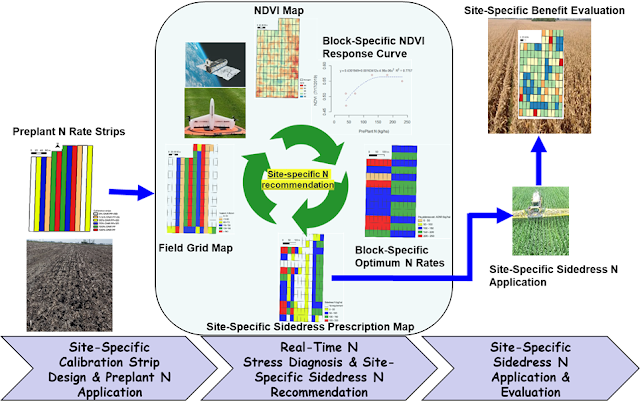Minnesota and Indiana corn growers needed for on-farm precision nitrogen management research project
Precision nitrogen management (PNM) has the potential to significantly improve corn growers’ nitrogen (N) use efficiency and reduce N losses. PNM aims to match N supply and crop N demand in both space and time. However, despite its great potential, the adoption of PNM technologies in the Midwest is still very low, with only about 20% of farmers adopting it. Supported by the Agricultural Fertilizer Research & Education Council (AFREC), the University of Minnesota’s Precision Agriculture Center (PAC) is developing cutting-edge PNM strategies and technologies for corn.
A major development in the field is remote sensing and calibration strip-based PNM technology for corn, which is illustrated in the image below. This PNM technology is a very practical way to help farmers improve N use efficiency and reduce N losses via leaching and other pathways. It is based on site-, year-, and hybrid-specific calibration, and can be implemented on any field. Satellite, aerial, or UAV remote sensing images can be used before the V8-V9 corn growth stages to guide sidedress N application.
On-farm research project
Recently, the USDA’s Natural Resource Conservation Service (NRCS) awarded a grant to the University of Minnesota to work with farmers and crop advisors to improve corn nitrogen management. Scientists at the University of Minnesota will work with the Minnesota Department of Agriculture and Purdue University to implement on-farm corn PNM trials in both Minnesota and Indiana. They will determine the agronomic, economic, and environmental benefits of this PNM technology under diverse on-farm conditions, and facilitate the adoption of this PNM technology by corn producers by establishing an On-farm Precision Agriculture Trial Network.Fields in Minnesota will be selected from areas at a high risk of N loss, including parts of the Central Sands region (Stearns and Sherburne Counties), southern Minnesota (Waseca and Blue Earth Counties), southeastern Minnesota (Mower and Fillmore Counties), and south-central Minnesota (Dakota and Rice Counties).
In Indiana, the farms will be selected from a range of vulnerable areas ranging from medium to very high risk according to the EPA classification for nitrate levels in drinking water. The farms will be located in areas of north-central Indiana with high risk of groundwater contamination (Jasper, Cass, Miami, and Carroll Counties), areas of central Indiana with medium-high risk (Blackford, Henry, Hendricks, and Shelby Counties), and areas of southern Indiana with medium-low risk (Dubois and Vanderburgh Counties).
The cooperating farmers will need to be eligible for the Environmental Quality Incentive Program (EQUIP) and have a crop advisor that is willing to cooperate with the project. Farmers who have management records for the past 8-10 years and are willing to share these with the research team are preferred, including yearly as-applied fertilizer maps, as-planted maps, yield maps, and soil sampling data. Fields are expected to be in the range of 50-120 acres.
Farmers with access to high clearance variable-rate sidedress N application equipment are preferred, but we will also consider farmers with regular variable rate sidedress applicators. The cooperating farmers will be asked to implement a series of preplant N rate strips across the study fields. Additionally, the cooperating farmers will be asked to apply a variable-rate sidedress N application to the field at the V8-V9 corn stage, based on a prescription map developed by the project team based on satellite remote sensing images taken before the V8-V9 corn stage.
Yield loss in the on-farm trial area will be compensated and an additional $1,000 will be paid to the farmer for their time and labor. The crop advisor will be paid $300 per field for their assistance with communications, on-farm trial design and implementation, data preparation, and other related activities. Participating farmers and crop advisors will be well-positioned to be early adopters of this innovative technology aimed at increasing profitability and reducing N losses to the environment.
Producers or crop advisors interested in participating in these on-farm trials should contact Yuxin Miao (ymiao@umn.edu) or Jeff Coulter (jeffcoulter@umn.edu) in Minnesota, and Davide Cammarano (dcammar@purdue.edu) or Bob Nielsen (rnielsen@purdue.edu) in Indiana.
This project is led by: Yuxin Miao, Associate Director of Precision Agriculture Center, Assistant Professor of Precision Agriculture and Nutrient Management, University of Minnesota; Jeff Coulter, Extension Corn Agronomist, University of Minnesota; David Mulla, Professor and W. E. Larson Endowed Chair of Soil and Water Resources, University of Minnesota; Davide Cammarano, Associate Professor of Digital Agriculture, Purdue University; and Bob Nielsen, Extension Corn Agronomist, Purdue University.
For the latest nutrient management information, subscribe to Minnesota Crop News email alerts, like UMN Extension Nutrient Management on Facebook, follow us on Twitter, and visit our website.
Support for Minnesota Crop News nutrient management blog posts is provided in part by the Agricultural Fertilizer Research & Education Council (AFREC).




Comments
Post a Comment